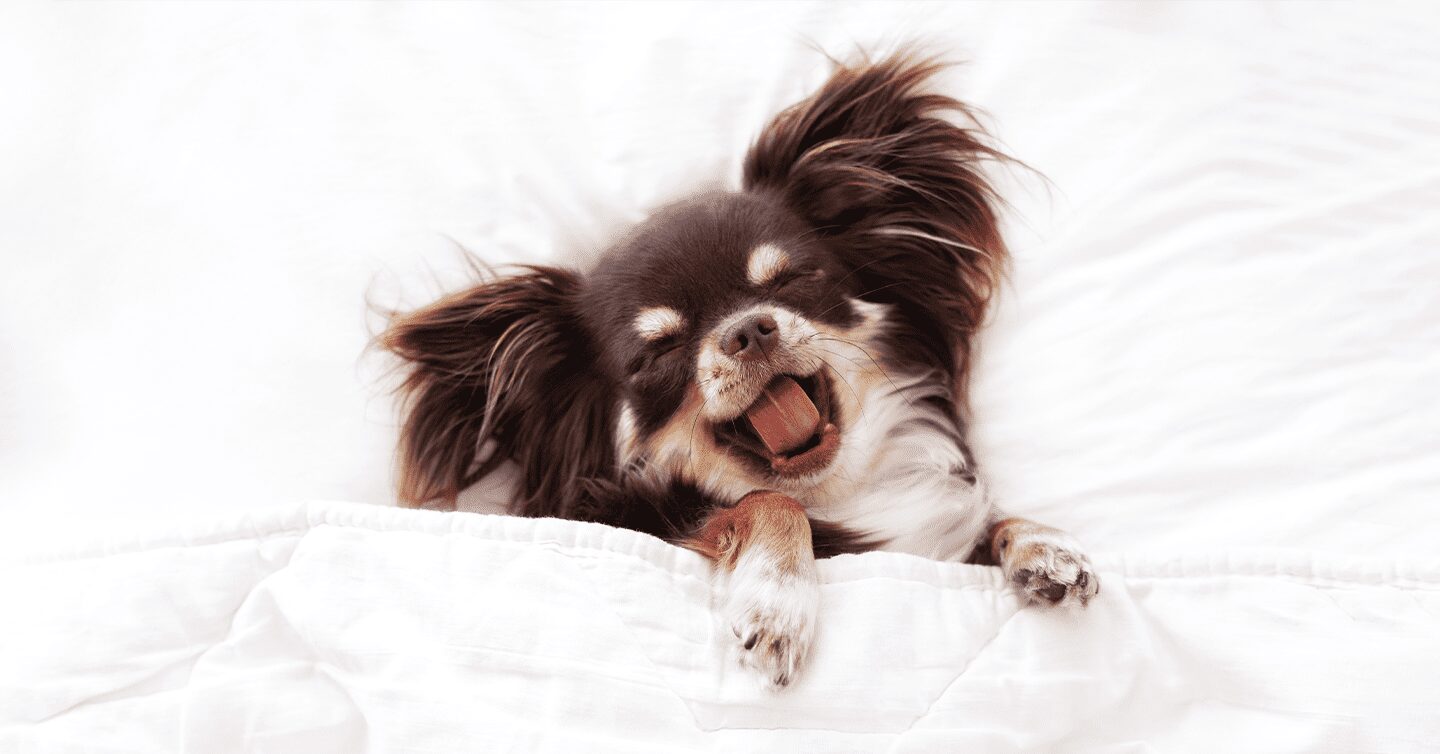Plenty of dog owners have asked themselves, “Do dogs dream?” at the sight of their snoozing pup.
If you’ve ever seen your dog twitch, whine, or even let out a bark or two while sleeping – chances are they’re dreaming.
But what is going on in their furry little heads? To better understand this phenomenon, let’s dive into the science behind doggy dreams.
Key Points
- Yes, dogs dream just like humans do!
- Sleep research has shown that dogs dream about their daily life to process those experiences – whether that’s chasing their ball or walking in the park with you.
- Twitching, barking, whining, the flitting of the eyes under the eyelids, and even the adorable tail wag are all signs your dog is dreaming.
- Never wake a sleeping dog! This can startle them and they can act out, not realizing they’re no longer in the dream.
The power of deep doggy sleep
To understand the mystery behind doggie dreams, we must first explore the science of sleep. Research shows the body needs sleep to repair and develop body systems. During this time, the brain processes daily experiences.
Now, there are four stages of sleep, but I’ll focus on the non-REM (non-rapid eye movement) sleep and REM (rapid eye movement) sleep stages for exploring doggie dreams. The other two stages are transition periods for the body to move into sleep or wakefulness.
A study examining the sleep and wake patterns of six Pointer dogs over 24-hour periods revealed that these dogs sleep for approximately 12-14 hours daily. Like humans, dogs cycle through wakefulness, Non-REM, and REM sleep cycles. Notably, they spend about 12% of their sleep in the REM or dream state.
Non-REM sleep (a deep sleep stage) is crucial in memory formation and daily activity categorization. During this stage, the brain’s hippocampus stores memories, and the individual experiences a slower yet regular breathing pattern, indicative of deep relaxation.
Scientists have found that all vertebrates, or creatures with backbones, experience Non-REM sleep. Intriguingly, even some invertebrates, such as fruit flies, may have some form of dream cycle.
Why do dogs dream the way they do?
REM sleep, or Rapid Eye Movement sleep, is a more active sleep phase that may invoke vivid dreams. When your dog enters this stage, typically 10-20 minutes after falling asleep, you may observe rapid breathing, muscle or foot twitching, and swift eye movements beneath their eyelids.
Research indicates that during REM sleep, the brain processes daily experiences. This phenomenon might explain why people sometimes find solutions to problems in their dreams. Well, dogs do this too.
This may be why you notice a puppy dreaming more frequently than an adult dog. Puppies are constantly learning and adapting to their new world – so they need all the processing power they can get!
Evidence that dogs dream
In 2001, researchers Matthew Wilson and Kenway Louie at the Massachusetts Institute of Technology (MIT) ran a study on laboratory rats and dreams. In this study, the rats ran mazes leading to food during the day, and researchers tracked their brain wave patterns.
Once asleep, the rat brain activity showed the same brain wave patterns, indicating they were going through the same activities they had experienced while awake.
The researchers matched the electrical activity of a rat’s daytime behavior with its brain activity during dreams, even pinpointing its location in the maze and whether it was still or moving. This study confirmed that animals dream. It also showed that their brain activity during dreams is similar to that of humans and involves experiences from their waking hours.
For your dog, this means they may dream about their interactions with you. These interactions may include playing fetch, walking, or chasing a squirrel. We also know that the size and breed of the dog can predict the types of dreams they will experience.
Factors that affect how dogs dream
While we can’t ask our furry friends what they dream about, certain factors could impact the content and quality of their dreams. From breed and age to their overall health and experiences, let’s take a closer look at the factors that could play a role in how dogs dream.
Breed tendencies
A fascinating study showed the differences in dog dreams between breeds and the sizes of dogs.
It focused on the Pons, the part of the brain that controls large muscle movements during sleep. When we sleep, the Pons shuts down our large muscle movement, allowing us to dream without physically acting out the dream.
Scientists in this study disabled the Pons in the dogs’ brains, allowing them to act out their dreams while they were still asleep. They found Pointers may point or search for imaginary games, Spaniels may dream of flushing out imaginary birds, and a Labrador Retriever may dream about chasing and retrieving a ball. The research suggests that, just like our dreams, the dreams of dogs are connected to actual experiences.
Age and size
Sleep researchers believe that size and age matter just as much as a dog’s breed. For instance, puppies and senior dogs dream more than middle-aged dogs. This is because puppies have underdeveloped Pons, and senior dogs can have less-efficient Pons.
Dr. Stanley Coren, a professor emeritus of psychology at the University of British Columbia and author of the fascinating book “Do Dogs Dream,” says that a dog’s size indicates the size of the dreams.
- Small dogs will have 60-second dreams every 10 minutes during the REM sleep stage.
- Medium-sized dogs will have 2-3 minute dreams every 30 minutes.
- Larger dogs will have 5-10 minute dreams every 60 minutes.
Generally, larger dogs tend to have longer dreams than smaller dogs. This is because the length of a dog’s dream is often related to its REM sleep cycle duration. Large dogs typically have longer REM cycles, which means that they may likely dream more and experience longer dreams.
On the other hand, smaller dogs have shorter REM cycles. This means they have shorter dreams that happen more quickly. Therefore, if you have a larger dog, you may notice they have more extended and intricate dreams than your smaller furry friend.
Signs your dog is dreaming
You may have seen your furry friend displaying some of these signs while asleep:
- Twitching
- Paw movements
- Leg kicks
- Eyes moving beneath their eyelids
- Irregular breathing
- Whining, barking, or even growling!
It’s important to note that not all dogs display these signs of dreaming, but it doesn’t necessarily mean they’re
Should I wake my dog up if they’re having a nightmare?
While it may feel instinctual to want to wake your dog if they seem upset or frightened during their dreams, it’s not wise to do so. Startling a sleeping dog could cause them to act out, not realizing they are no longer in their dream.
Instead, let your dog sleep and work through the dream on their own. If you must wake them, try calling their name or dropping an object on the floor to gradually bring them out of their sleep without startling them too much.
Remember, like humans, dogs need restful sleep, and their dream state is just a part of that!
FAQs
What do dogs dream about?
While we can’t be certain what dogs dream about, their dreams are believed to be connected to their daily experiences and activities. Dogs may dream about playing, chasing, or interacting with their favorite humans or animals. It’s also possible that dogs may dream about past experiences or memories.
Do dogs have bad dreams?
Yes, just as dogs can dream about happy experiences. So, it makes sense to believe they also dream about frightening or concerning ones. Your dog could dream about fights with another dog, being alone, or thunderstorms. You could notice them yelping or whining during sleep.
How often do dogs dream?
Dogs can dream multiple times during a sleep cycle and spend around 10 to 15 minutes in the dream state per cycle. The frequency of their dreams depends on their age, size, and sleep patterns.
Do dogs dream about their owners?
Yes, dogs can dream about their owners. Research suggests that dogs are more likely to dream about their owners or animals they have interacted with. This is often accompanied by physical signs like tail wagging, whimpering, and even movements that mimic playing or cuddling with their owners.
The bottom line on dog dreams
So do dogs dream? Yes, dogs dream just like humans! When dogs are in a deep sleep, you may notice their muscles twitch, paws paddle, and eyes moving rapidly.
And since dogs are so attached to their pet parents, chances are they’re having sweet dreams about interacting with you – how amazing is that?




